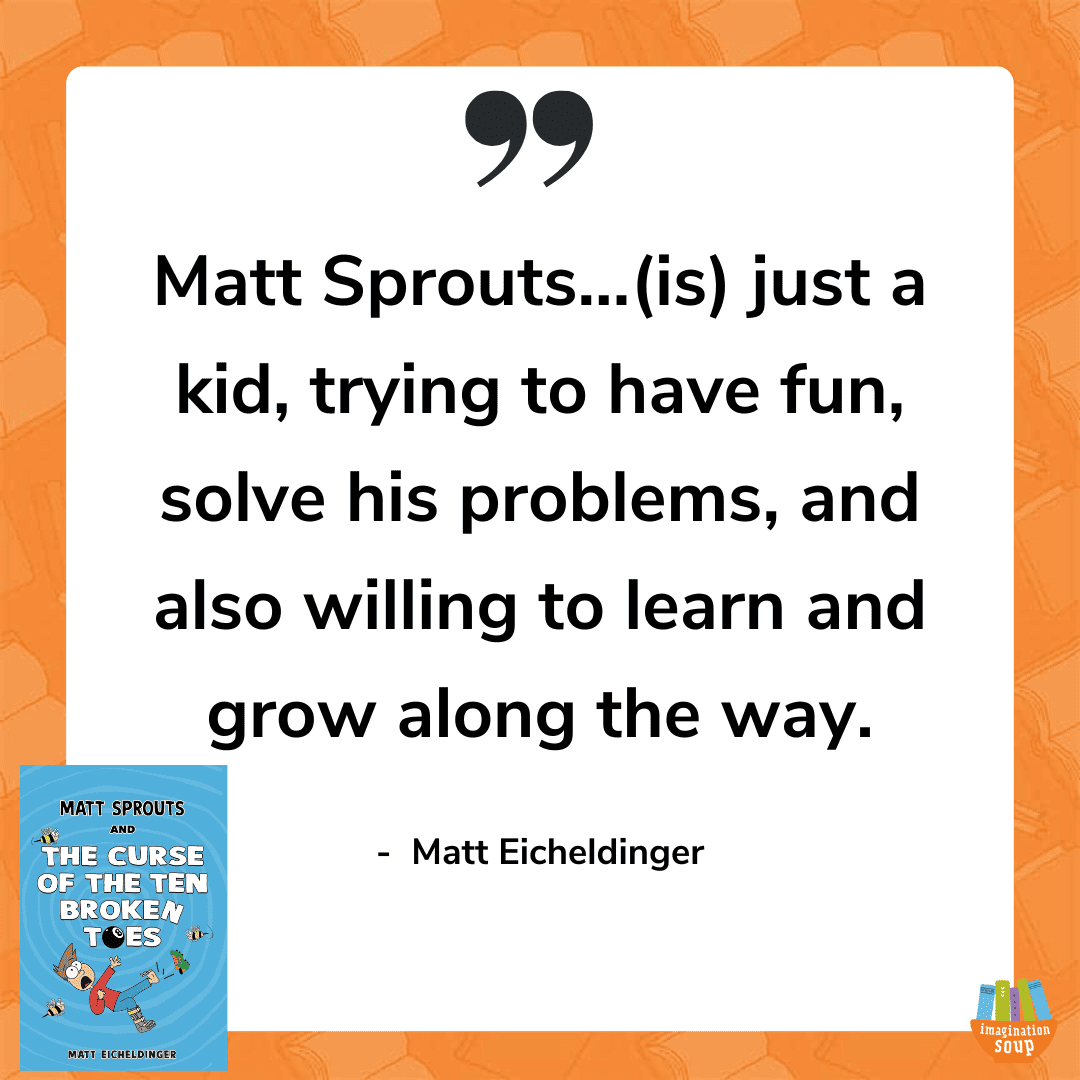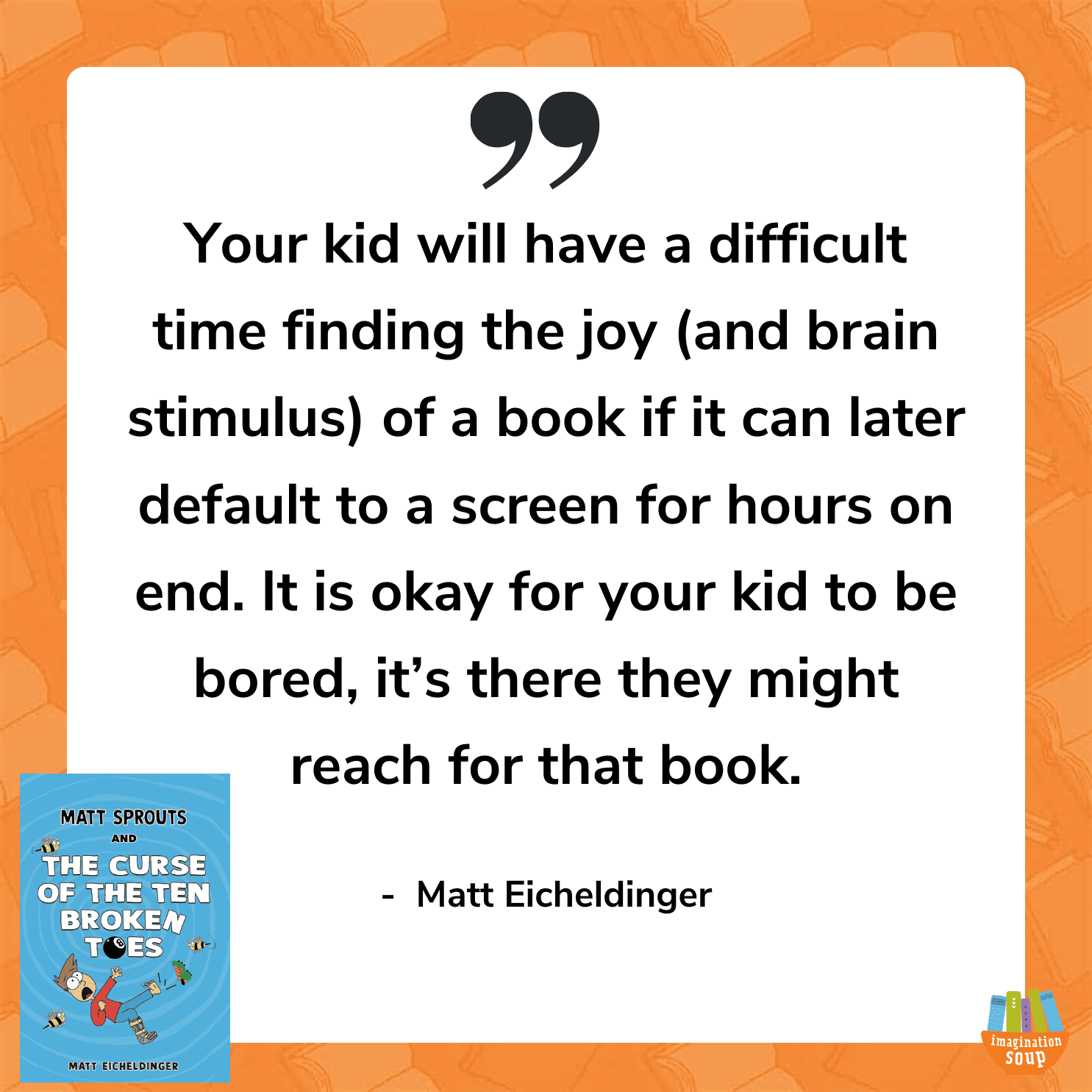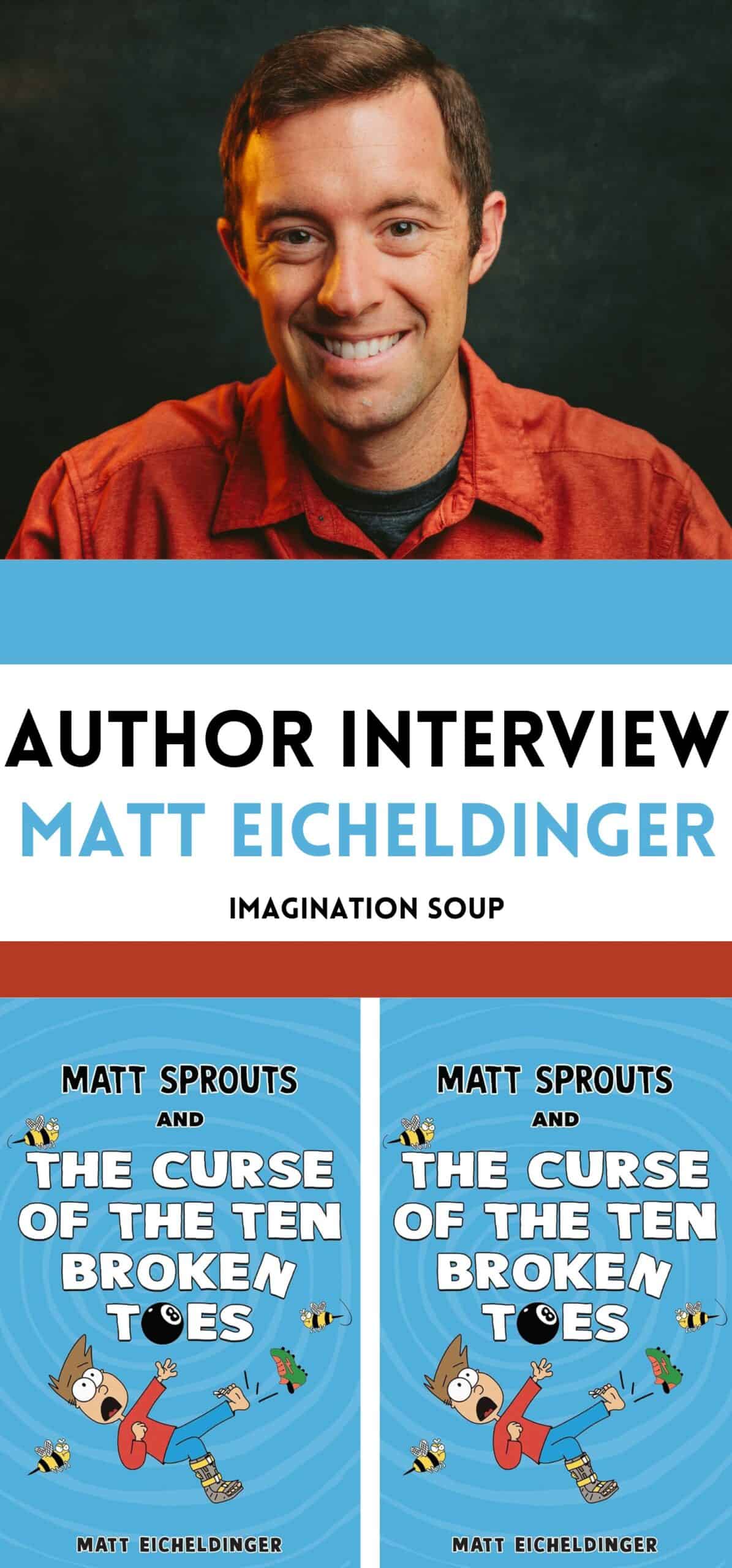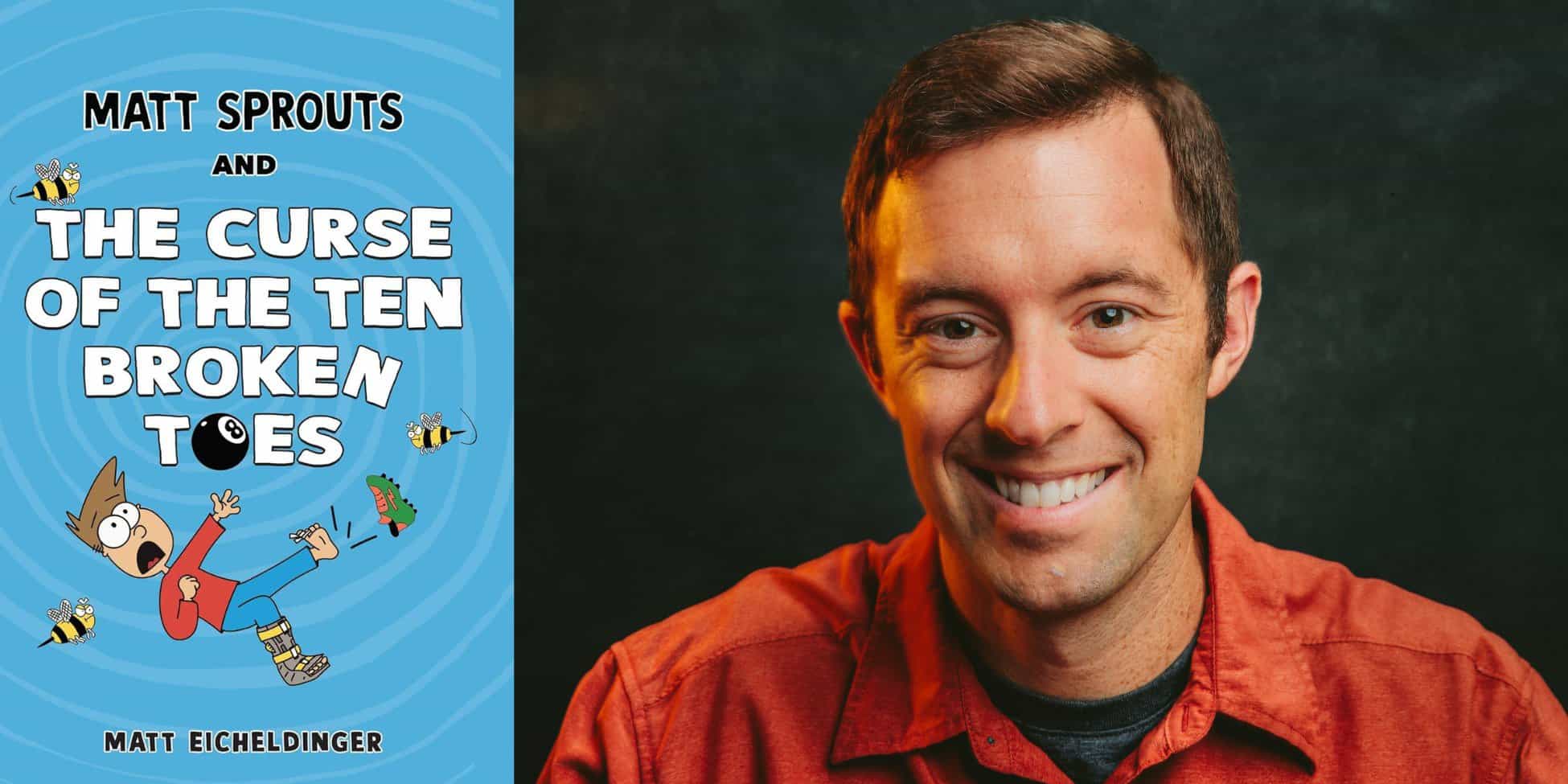Superstar storytelling teacher Matt Eicheldinger is well-known for his inspiring Instagram stories filled with life lessons from the classroom. Matt continues to enrich our lives with his illustrated humorous middle grade novel, The Curse of the Ten Broken Toes.
The Curse of the Ten Broken Toes is closely based on Matt’s actual childhood—and the curse that “got him” one year, which resulted in ten broken toes, among other disasters! It’s a great read for kids who love realistic, funny stories.
I was thrilled to interview Matt over email about his career, new book, and advice for growing writers and parents of reluctant readers. You’re going to love our conversation — and want to buy Matt’s new book.

Interview with Teacher Author Matt Eicheldinger
Melissa: Since this is based on your childhood, how did you remember so many details? (I’m impressed!)
Matt: I have a really good memory, particularly when it comes to my own childhood. I am not sure why, but it’s always been that way. If I sit and think about what it was like to enter my third-grade classroom, I strongly feel what I felt that day. If I were to take a guess as to why my brain decided to remember things in this way, I suspect it’s because of my parents. They told stories most nights as they tucked me in; fictional stories about me defeating warriors or scoring a winning goal. I think hearing stories so often made me look at my own life as a story, like I was watching myself in third-person point of view, if that makes sense. And because stories can embed themselves so deeply in our soul, it might explain why I remember so much. I was just watching a story, and the story I was watching was of myself.
Melissa: What do you hope readers get out of this story?

Matt: I originally wrote this story for reluctant or struggling readers. I wanted a plot that moved quickly, plenty of funny moments, and a character who was relatable, but not perfect. When kids read Matt Sprouts, I want them to see all the mistakes Matt makes, but I also want them to see that he was always aiming for something good in his journey, and he was willing to change. And that is who Matt Sprouts is. He’s just a kid, trying to have fun, solve his problems, and also willing to learn and grow along the way. The sequels for Matt Sprouts lean more into this idea too.
Melissa: How did you decide where to put the illustrations?
Matt: I really only wanted to draw a few characters at the time, Matt and Grace. This is because I wasn’t as confident as an artist as I am now and because I wanted the reader to envision the characters on their own (which is why I will never draw The Purple Grape Lady!). I have since drawn characters that appear in the first book in other sequels, and part of me wishes I would have had the confidence to create them for the first book. Altogether though, I was just trying to give the reader something to look at every 3-4 pages.
Melissa: How did you find time to write when you have a busy teaching career?
Matt: It was not easy, that’s for sure. Writing was actually the easiest part, believe it or not. Since it is basically a collection of real stories of my childhood (exaggerated for the book, of course!), it was easy to write it all out, which I did in under thirty days. I thought that was a fluke, but that’s how I wrote the other two as well. It was the letters I had to write to agents that took the most time. They all had to be researched and individualized, and I found myself up late at night and using weekends to get this done.
Melissa: What’s your best advice for young writers?
Matt: I have two pieces of advice. The first is to get someone in your intended audience to read your book and give you feedback. I had hundreds of students read my book, and it helped me fine tune some scenes and character develop, and also gave me motivation to continue because the feedback for the book was positive.
The second piece of advice is to finish the project. I have been surprised to see how many writers ask for advice on how to get published when they have yet to finish a project. Your work, whatever it is, needs to be ready when your opportunity comes because you never know what might pop up when you least expect it.
Melissa: What’s your best advice for grown-ups who want their readers to read more?
Matt: I will approach this question in a few parts, because as a teacher I have a lot to say, but I will try and keep it short.
First, if you have a child who is reluctant to read, you are not alone. Even as a language arts (reading and writing) teacher, our own two kids were resistant to read at certain points in elementary school. There are so many tips I have to help with reluctant readers, but here are a few:
Electronics
If you have a child who is very reluctant to read, I would be curious to know how much time they spent on a phone, video games, or other device. Why would a brain want to exercise in a book when instead it could be lazily fed from a brighter, flashy, stimulating screen?

The catch is an engaging book can easily outperform the screen and capture the brain in a way a screen cannot. However, to give the brain a chance, you need to greatly reduce screen time. Your kid will have a difficult time finding the joy (and brain stimulus) of a book if it can later default to a screen for hours on end. It is okay for your kid to be bored, it’s there they might reach for that book.
Time
Something that worked for us was carving out dedicated time to read but not just for our kids, all of us. Whether it was sitting in the living room together to read, or reading a chapter book together, we made it a priority for our kids to understand that reading wasn’t just an assignment, it could be something we did together.
We also gave them ownership of the process too; going to used bookstores to buy books, spending time at the library, checking out a lot of books to figure out what they liked and didn’t like, and never making them finish a book they didn’t like.
Book Choice
I’ve talked to many parents who were concerned their child would only pick up a comic, or a graphic novel. However, they are reading, right? Give it some time. Outside of school, I only read Calvin and Hobbes growing up (seriously!), and I discovered other books later in junior high and high school. But if you think your child needs to move on to something else then here is my last tip:
Experts

If you have a child who reads a little bit, but you want them to dive deeper or find something new, then you need to give them the chance to do so. The best resource you have is your school and public librarians, and booksellers at local bookstores. The amount of knowledge they have on books is better than any “10 Best Books to Give Your Child” blog. Head to your local library or even a bookstore, and have your child talk with a bookseller or librarian. Sometimes all kids need is someone who is not their parent or teacher to point them in the right direction.
About Matt Eicheldinger

Matt Eicheldinger has been teaching middle school language arts for the past fifteen years, where he’s become known for his storytelling method. He has also created a growing audience on social media, becoming one of the top-followed teacher accounts on Instagram. This past year, Eicheldinger signed multiple book deals with Andrews McMeel Publishing, with the following projects set to be released in 2024/2025.
–Matt Sprouts and The Curse of The Ten Broken Toes (Middle Grade Fiction, March 2024)
-Matt Sprouts and the Day Nora Ate the Sun (Middle Grade Fiction, September 2024)
-Sticky Notes: Memorable Lessons from Ordinary Moments (Adult Nonfiction, October 2024)
-Holes in My Underwear (Elementary/Middle Grade, Summer 2025)
-Matt Sprouts and The Search for the Chompy Wompers (Middle Grade Fiction, Fall 2025).
You can learn more about these projects at matteicheldinger.com, or follow him on Instagram for more stories @matteicheldinger.


 PARENTING TIPS
PARENTING TIPS







 PREGNANCY
PREGNANCY








 BABY CARE
BABY CARE








 TODDLERS
TODDLERS








 TEENS
TEENS








 HEALTH CARE
HEALTH CARE






 ACTIVITIES & CRAFTS
ACTIVITIES & CRAFTS








 CONTACT
CONTACT ABOUT
ABOUT



















